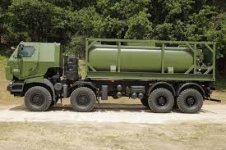It varies depending on whether the vehicle accompanies tracked fighting vehicle or runs back and forth between replenishment points. For example in a tracked self propelled artillery battery, the ammunition vehicle limber vehicles and the recovery vehicle are tracked (as are command posts, recce vehicles, troop sergeant majors, forward observers and the FSCC) while additional ammunition vehicles which move between the battery and ammunition points, and pretty much all other support vehicles are wheeled.
I can't speak for todays armoured squadron but in my ancient past, the A1 echelon which accompanied the tank squadron had tracked vehicles for: the squadron sergeant major who replenished food, water and other miscellaneous stuff, the POL vehicle (carrying jerry cans), the Ammo vehicle, the ambulance, the ARV and the MRT.
@Fishbone Jones would know much better than I.
Essentially the A1 echelon supplies the tanks, the A2 Echelon, where the SQMS is, supplies the A1 Ech, the Regt A2 Ech supplies the Squadron A2 Ech and the Svc bn supplies the Regt A2 Ech. All of this gets done at night so it becomes a bit obvious why fuel tankers from the Svc Bn refueling the tanks is not a regular thing although in some circumstances, where the resupply is more administrative than tactical, it could happen.
Unfortunately, our purchase of tracked logistics vehicles is long gone. Most everything these days is wheeled primarily for budget reasons. The ACSV purchase has finally moved forward to putting a number of modern close support vehicles under armour with the basic LAV chassis.






